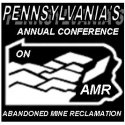By Andy McAllister, WPCAMR Regional Coordinator, with additions by Robert E. Hughes, EPCAMR Executive Director
As you are all aware, even with the Title IV funding from the Surface Mining Control and Reclamation Act, there isn’t enough money to totally clean up Pennsylvania’s immense AMD/AML problems. Our challenges far outweigh available resources. No one organization or government agency can do it alone. We as a community have been very well aware of this for quite some time. Many in our community think it’s about time that we start seeing AMD as a resource.
EPCAMR and others have thought outside of the box and are selling the iron oxide as a raw pigment on a small scale for now, but it could blossom into a viable full-blown recycling process and business to support itself in the future, given some working capital and investment by the private sector. EPCAMR is also in the process of evaluating the integrity and estimated volumes of mine water that is contained within underground multi-colliery hydrogeologic units, called mine pool complexes throughout the entire Anthracite Region and in parts of the Northern Tier (Sullivan County, Bernice Mine) and has even developed several 3D models of the underground workings and the coal veins and barrier pillars between them. if they remain. The Wyoming Valley and the Lackawanna Valley are on EPCAMR horizon to be completed as funding allows the Staff to continue working on its development. This mine pol water is an untapped reservoir. Billions of gallons of water, unused. Does it come with its own set of risks? Yes. What is the level at which the water can be drawn down in certain mine pools safely without impacting the surface potentially? This needs to be looked at further. More detailed interpretation and analyses of our historic mine maps and geologic cross sections need to be reviewed. Does the water quality vary at different depths in the mine pools? EPCAMR believes that it does and further studies are necessary to determine just how bad from a treatment standpoint or industrial use application, such as the Shale Gas Industry. What interactions can occur within the Marcellus play when AMD is introduced into the hydraulic fracturing picture? We’re not certain. Would we like to explore the possibilities? Sure, in a controlled environment.
Pennsylvania’s Abandoned Mine Reclamation (AMR) community has a long history of working cooperatively with industry, government, and others for our common good. Our community, perhaps more than any other environmental movement, has understood the value of working together and partnering with industry. We’re celebrating 15 years in August of this community, as we continue to coordinate the longest running State-wide Conference on Abandoned Mine Reclamation, in State College, PA on August 8-10th, at the Ramada Inn. See www.treatminewater.com for details.
Several years ago, some forward thinking individuals thought to encourage the use of AMD by the shale gas industry. EPCAMR supported this idea and encouraged groups like the SRBC to do the same. That idea progressed and more and more people thought it was a good idea.
Not long after the DEP began crafting the whitepaper, “Utilization of Mine Influenced Water for Natural Gas Extraction Activities “, conversations ensued about liability in using AMD. Representatives from the shale gas industry were concerned that liability, from their standpoint, would be one of the issues that would stand in the way of widespread use of AMD for fracking.
The use of AMD by the shale gas industry holds a lot of potential for our community. Making lemonade out of lemons, it could be a way for watershed groups and Conservation Districts to secure operation and maintenance funds for their AMD treatment systems and, quite possibly, to work with industry to secure funding to construct additional treatment systems. Another plus for this idea is that our existing potable water supplies and our healthy streams and rivers can be conserved. Why continue to pull water from clean streams when AMD water might just as well be as suitable with a little treatment?
Are there hurdles to the use of AMD by the shale gas industry? Absolutely. According to experts in the shale gas industry, sulfate concentrations in AMD and the issue of liability are the two biggest hurdles that need to be overcome. Is this some sort of cure-all for our AMD problems? No way. However, it is an opportunity that needs to be explored. As we hear many times, “It’s another tool in the tool box”.
During the last legislative session, the PA General Assembly considered SB 1346, sponsored by Senator Kasunic, which limited liability for those involved in using AMD for shale gas operations or for any other industry for that matter. The bill never got the traction it needed to progress.
The concept of liability protection for using AMD by industry has been resurrected in this session as Senate Bill #411, “An Act Amending Title 27 (Environmental Resources) of the Pennsylvania Consolidated Statutes, further providing for definitions, for eligibility and project inventory, for landowner liability limitation and exceptions, for project liability limitation and exceptions and for exceptions.”, again sponsored by Senator Kasunic and endorsed by 15 other legislators.
SB411 is currently on the table in the Senate. It may be up for a vote this week. People should look closely at this bill and read the language very carefully.
At this time, there is a lot of push back from environmental groups outside of our AMR community regarding the use of AMD by the shale gas industry. To our knowledge, they have not proposed any alternate plans for providing operation and maintenance funding to ensure the perpetual treatment of AMD or alternate ways to find construction funding to build AMD treatment systems. Most have not been instrumental in providing solutions to help the AMR community achieve its goal, they simply wish to stop fracking and that is their right.
Now is a very good time for you, who are out in the trenches working on AMD treatment and support the AMR community, to weigh in on the issue and have your voice heard by the General Assembly, both on the use of AMD by industry and the importance of protecting watershed groups, Conservation Districts, and their partners from liability as they seek to find innovative ways to secure operation and maintenance funding for their treatment systems.
A quick email to your legislator or perhaps a phone call to his or her office will ensure that they hear your voice. Send an email to your legislators and let them know how you feel. To find the contact information for your legislator, go to:
http://www.legis.state.pa.us/
To see the text of Senate Bill 411, go to:
http://www.legis.state.pa.us/
To see DEP’s whitepaper on the use of AMD by the shale gas industry, go here:
http://files.dep.state.pa.us/
For additional articles on the issue, go to these links:
http://stateimpact.npr.org/











